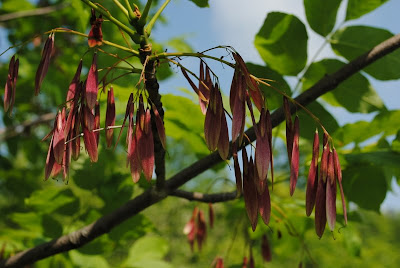Looked up at the sky the other evening, just after the sun had disappeared behind the trees, and the sky was mottled with a 'mackerel' pattern of small altocumulus clouds, scattered across half the horizon. Seemed like an interesting sight to mark the summer solstice, since we're not planning any bonfires or midnight dancing to celebrate here!

I'm not sure that a mackeral sky foreshadows any particular type of weather, but I did find a saying - 'mackeral sky; three days dry'. We only got two dry days after it, but we did get a lot of garden work done in those two days.

The summer solstice is a time of year when crops have been planted, the weather is warm, and we look forward to the future harvest, even if the days start getting shorter now. Awake at 1 a.m. last night, on the shortest night of the year, it wasn't really even dark. Both the garden and the meadow are bursting with life now, flowers blooming, birds raising young, and the summer insects beginning to call.
Summer solstice is one of those landmark days if you're paying attention to the seasons, and has been for thousands of years. It reminds me of the giant stone circles in Scotland, where there likely were people celebrating at midnight earlier this week, and for thousands of years before. These photos are of the standing stones in the Ring of Brodgar, where we visited two weeks ago. You quickly start imagining the world 5000 years ago when you stand among these stones. There is some suggestion that this stone circle was known as the 'Temple of the Sun'.

 It's ridiculously cool today, about 10 degrees this morning, and wet, but a few days ago in the warm, the swallowtail butterflies appeared, as they seem to every year. Apparently swallowtails don't migrate, and the pupae can overwinter, so once it warms up in the spring, the butterfly can emerge.
It's ridiculously cool today, about 10 degrees this morning, and wet, but a few days ago in the warm, the swallowtail butterflies appeared, as they seem to every year. Apparently swallowtails don't migrate, and the pupae can overwinter, so once it warms up in the spring, the butterfly can emerge. They fly back and forth, up and down, meandering from flower to flower, fluttering in the breeze. They seemed to really enjoy the lilac blooms, going back to those repeatedly. One also sat still on a 'wooden heron' we have, enabling me to get some good pictures.
They fly back and forth, up and down, meandering from flower to flower, fluttering in the breeze. They seemed to really enjoy the lilac blooms, going back to those repeatedly. One also sat still on a 'wooden heron' we have, enabling me to get some good pictures.











